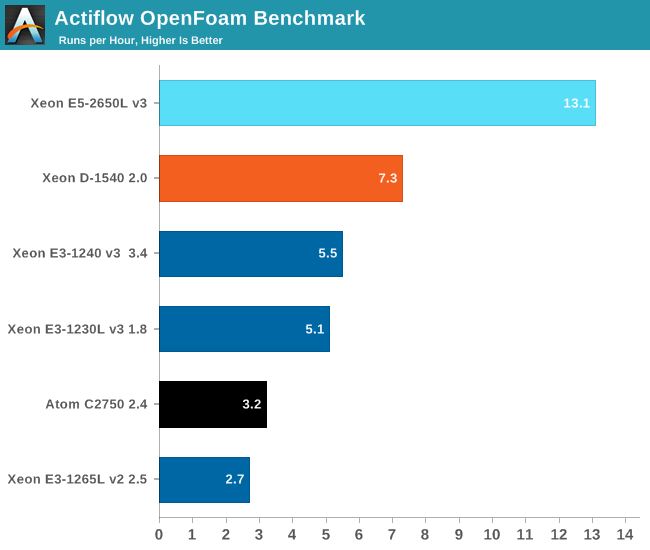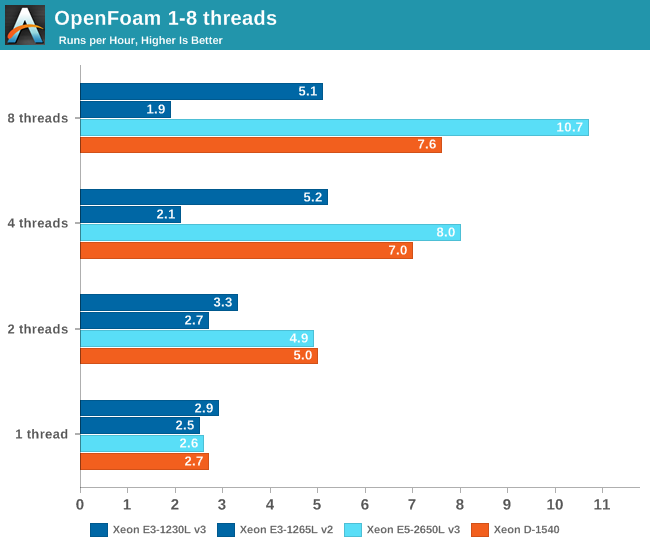The Intel Xeon D Review: Performance Per Watt Server SoC Champion?
by Johan De Gelas on June 23, 2015 8:35 AM EST- Posted in
- CPUs
- Intel
- Xeon-D
- Broadwell-DE
OpenFoam
Computational Fluid Dynamics is a very important part of the HPC world. Several readers told us that we should look into OpenFoam and calculating aerodynamics that involves the use of CFD software.
We use a realworld test case as benchmark. All tests were done on OpenFoam 2.2.1 and openmpi-1.6.3.
We also found AVX code inside OpenFoam 2.2.1, so we assume that this is one of the cases where AVX improves FP performance.

HPC code is where the Xeon E5 makes a lot more sense than the cheaper Xeons. The Xeon E5 is no less than 80% faster with 50% more cores than the Xeon D. In this case, the Xeon D does not make the previous Xeons E3 look ridiculous: the Xeon D runs the job about 33% faster. Let us zoom in.

OpenFoam scales much better on the Xeon E5, and we've seen previously that a second CPU boost performance by 90% offering near linear scaleability. Double the number of cores again and you get another very respectable 60%. Eight cores are 34% faster than four, and 4.1 times faster than one.
Compares this to the horrible scaling of the Xeon E3 v2: 4 cores are slower than one. The Xeon E3 v3 fixed that somewhat, and doubles the performance over the same range. The eight cores of the Xeon D are about 2.8 times faster than one - that is decent scaling but nowhere near the Xeon E5. There are several reasons for this, but the most obvious one is that the Xeon E5 really benefits from the fact that it has almost twice the amount of bandwidth available. To be fair, Intel does not list HPC as a target market for the Xeon D. If the improved AVX2 capabilities and the pricing might have tempted you to use the Xeon D in your next workstation/HPC server, know that the Xeon D can not always deliver the full potential of the 8 Broadwell cores, despite having access to DDR4-2133.










90 Comments
View All Comments
Flunk - Tuesday, June 23, 2015 - link
Yes, but it's still bad marketing. -D is associated with inferior, overly hot, bad performing Intel chips.IanHagen - Tuesday, June 23, 2015 - link
Certainly. From a marketing standpoint it's a pretty poor choice. I agree with wussupi, E4 would haven been a far better name.karpodiem - Tuesday, June 23, 2015 - link
does anyone know where to buy these online? I'm looking for just the board/processor, model # 'X10SDV-TLN4F'All these random/small Supermicro resellers are selling it now, based on some Google searches. They're marking it up in price by at least a hundred bucks, because availability is limited. Anyone know when Newegg might get it in stock?
Looking to do a FreeNAS build - this board + IBM M1015 card in an ATX motherboard (6x4TB drives in RAIDZ2).
ats - Tuesday, June 23, 2015 - link
The TLN4F is the one in most demand and almost no place is able to keep it in stock. There are multiple places that will order it for you for ~1K but wait times can be anywhere from 1 week to 1 month.Jon Tseng - Tuesday, June 23, 2015 - link
> And the reality is that the current SoCs with an ARM ISA do not deliver the necessary per core> performance: they are still micro server SoCs, at best competing with the Atom C2750. So
> currently, there is no ARM SoC competition in the scale out market until something better than
> the A57 hits the market for these big players.
Dude... You really want to have a look at the latest ThunderX parts or the X-Gene 16nm shrinks before you start making unwise statements like that. These aren't waiting around for A57 they are custom ARM architecture designs. Per core performance might not be as hot as Xeon but once you start to throw 48 cores on a die I wouldn't quite call that "at best competing with Avaton".
smoohta - Tuesday, June 23, 2015 - link
Link to reviews?ats - Tuesday, June 23, 2015 - link
X-Gene is in the article, any further shrinks are still entirely vapor. ThunderX isn't currently available is is likely to have significantly worse per core performance than Atom C2k series and worse than A57. All the cores in the world don't do jack if the ST isn't there. And ST performance IS a barrier even in scale out. For general scale out, C2750 was found fairly wanting because of the ST performance, and neither X-Gene nor ThunderX even compete with C2750 in ST performance... QED.mczak - Tuesday, June 23, 2015 - link
He said "currently". The X-Gene 16nm cores might offer some competition who knows - but those are X-Gene 3 whereas you can't even buy anything with X-Gene 2 28nm ones right now... Likewise, ThunderX servers have been announced, but I haven't seen any reviews yet.name99 - Tuesday, June 23, 2015 - link
Look at the ThunderX parts HOW? Cavium releases fsck-all information about them. No-one knows if they are even OoO, how wide they are, etc.Yes, there are 48 cores on a SoC; and presumably they will do well for tasks like memcached that like lots of low-performance parallelism. But right now, we have ZERO evidence that a ThunderX part is a better single-threaded core than A57, let alone that it's comparable to Broadwell.
der - Tuesday, June 23, 2015 - link
NOICE FAM!